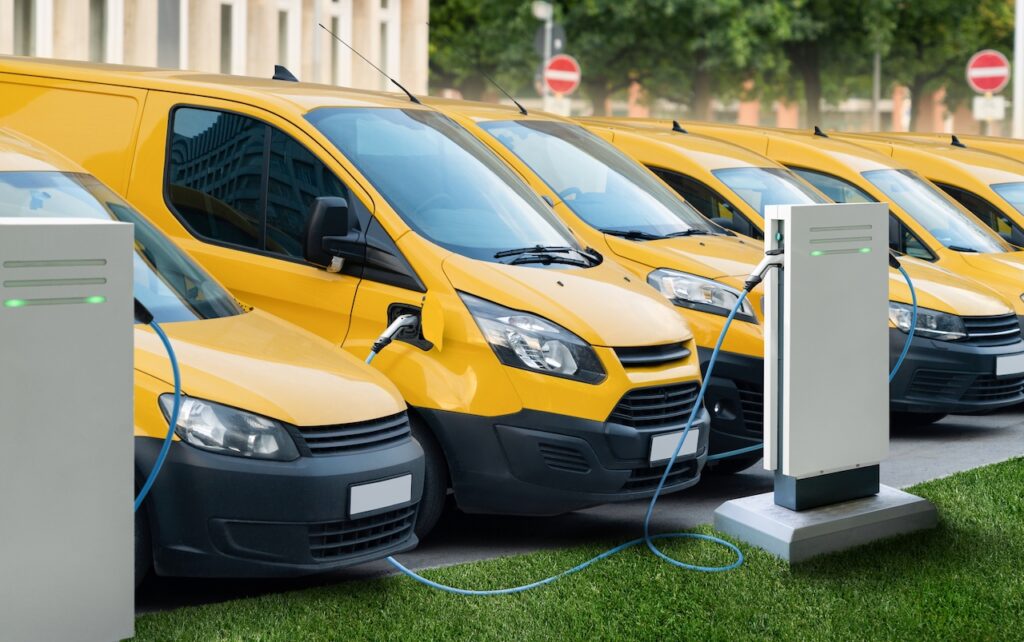Overcoming the roadblocks: Electric vehicle adoption in small and large logistics companies
Overcoming the roadblocks: Electric vehicle adoption in small and large logistics companies

Authored by Valentine Desreumaux & Harry Dobbs
Almost all logistics giants, including Amazon and DHL, have made recent promises to transition towards carbon free delivery in the coming decades. An increasingly popular way for companies to achieve ambitious emissions targets is through the uptake of electric delivery vehicles. However, the adoption of EVs still faces many challenges, resulting in slow adoption rates and limiting usage for last mile delivery.
Barriers to EV adoption are particularly difficult for small companies to overcome. With limited capital available to invest, smaller companies face affordability challenges related to the transition towards electric vehicles and the necessary charging infrastructure.
A series of thirteen interviews with multinational and local logistic operators across three European countries revealed significant differences between large, medium, small, and micro-sized companies with regards to their ability to adopt electric delivery vehicles. The interviews focused on the operations of each company in order to identify the feasibility of adopting electric vehicles for delivery, alongside their willingness to make the transition. For analysis purposes, the four company sizes were split into three groups, with small and micro-sized companies grouped together as they face similar challenges.
Large companies often operate internationally and are publicly well known. They can benefit from the use of zero-emissions vehicles through impactful marketing campaigns, as increasing numbers of customers value sustainability initiatives from companies with the resources available to make an environmental impact. Of the large companies interviewed, all are using electric vehicles for last mile delivery in some respect, most commonly in urban zones. Nowadays, larger companies see the use of electric delivery vehicles as a way to gain competitive advantage and increase business, resulting in benefits for both the company and the environment.
Medium-sized companies typically have capital available to make the necessary purchase, but require a guaranteed return on investment before committing to any major operational changes. In general, all companies need to ensure profitability through their operations, but larger companies can usually take greater risks. When reviewing the position of interviewees from medium-sized companies, two general viewpoints are acknowledged. Some organisations find that they are attracting increased business because of their use of electric vehicles for delivery. Meanwhile, other companies have established their operations without electric vehicles, and prefer to wait for clients and customers to demand sustainable delivery options before making the switch.
The overarching challenge for smaller companies is their ability to invest.
For small and micro-sized companies, attitudes towards electric vehicle adoption are similar to those of medium-sized companies. When referring to this group, we consider subcontractors, who often support last mile delivery of products and goods. These companies rely on the support of their customers in order to be able to invest in electric vehicles, as they require guaranteed business in order to cover the costs. The overarching challenge for smaller companies is their ability to invest.
The willingness to find solutions to overcome electric vehicle investment challenges was clear for interviewees that identified that using an electric vehicle to support their operations was feasible, commonly for shorter routes in urban or sub-urban areas. Innovative ways to make electric vehicle adoption more affordable were also explored, including the option of leasing, or the opportunity to conduct pilots with electric vans. However, for smaller companies the required investment represents a more significant risk, and companies need some insurance that the vehicles are trustworthy and that they can make use of them across multiple operations.
Organisations with fewer workers generally require fewer vehicles. Smaller companies typically desire versatility amongst their vehicle fleet, allowing for maximum value to be gained from any investments as the vehicles will constantly be in use. Regarding reliability, well-known and reliable brands appear to be a key factor when considering an investment in electric vehicles. Interviewees were willing to pay a premium for vehicles that have proven to be more reliable, as maintenance costs will be lower. Therefore, it is important for EV suppliers to demonstrate the trustworthiness of their vehicles for various use cases.
The willingness to use electric vehicles is also a personal choice and depends on the complexity and range of operations. All the interviewed companies are aware of the push towards the use of more sustainable vehicles and delivery, but opinions over electric vehicles varied. While some view the use of electric vehicles as a natural progressive step, others have reservations regarding reliability and profitability for their operations. Indeed, it seems impossible to perform deliveries in rural areas based on the current autonomy of the vehicles and the current infrastructure grid.
If the goal is to make electrification more widespread and include small companies in the energy transition, support is needed from governments and larger organisations. Examples of this help include incentives targeting small and medium-sized companies and increased numbers of public fast-charging infrastructure. Electric vehicles are clearly part of the solution for more sustainable logistics, but might not be the only option. Additional innovative solutions mentioned during the interviews include the use of cargo bikes or sharing space within the same larger delivery vehicles to reduce kilometres driven.
In conclusion, the challenges facing small and large companies in logistics vary greatly, both in terms of financial and operational barriers. The future of last-mile delivery is green, but how quickly the industry reaches it depends on active collaboration to enable the widespread adoption of electric vehicles.
Thank you to all the interviewees for their time and contributions.
This article is based on the findings from a thesis that will be published in the upcoming months.
Sources:

